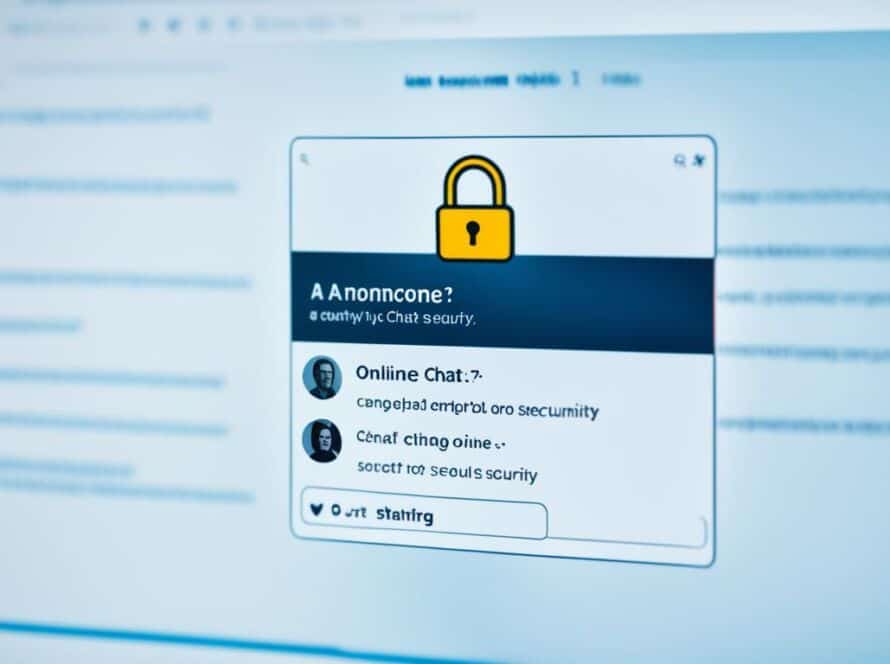Did you know that over 90% of American teenagers engage in online chatting? With the proliferation of social media platforms and messaging apps, the digital world has become an integral part of teenage life. While online communication offers incredible opportunities for connection and self-expression, it also comes with its share of risks and challenges. Ensuring teen chat safety has become more crucial than ever before.
Key Takeaways:
- Over 90% of American teenagers participate in online chatting.
- Teen chat safety is a crucial aspect of navigating the digital landscape.
- Online communication offers opportunities for connection but also presents risks.
- The following sections will provide valuable insights and guidelines to help teenagers chat safely.
Understanding the Risks of Online Chatting
In today’s digital age, online chatting has become an integral part of teenagers’ lives. While it provides a platform for communication and connection, it also comes with inherent risks that can compromise their cybersecurity and digital well-being. It is crucial for teens and their parents to be aware of the potential dangers and take necessary precautions to ensure a safe online experience.
The Implications of Cybersecurity for Teens
Cybersecurity is a significant concern when it comes to online chatting for teenagers. The internet is populated with individuals who may have malicious intentions, such as hackers and cyber predators. These individuals can exploit vulnerabilities and gain access to personal information, leading to identity theft, online harassment, and even offline dangers. It is essential for teens to understand the importance of protecting their personal information and maintaining strong cybersecurity practices to safeguard themselves from such threats.
Common Threats in Cyber Communication
There are several common threats that teenagers may encounter while engaging in online chatting. These threats include phishing attacks, malware-infected links, and social engineering scams. Phishing attacks aim to deceive users into divulging sensitive information, such as usernames, passwords, and credit card details. Malware-infected links can lead to the installation of malicious software that can compromise the security of a teenager’s device. Social engineering scams involve manipulation techniques to trick individuals into sharing personal information or performing actions that they should not. By being aware of these threats, teens can identify and avoid potential risks, ensuring their safety while communicating online.
Role of Digital Well-being in Chat Safety
Engaging in online chatting can have both positive and negative impacts on a teenager’s well-being. It is essential to maintain a healthy balance and prioritize digital well-being while using chat platforms. Excessive screen time, cyberbullying, and online harassment can negatively impact mental health and overall well-being. Teenagers should be encouraged to cultivate healthy online habits, such as setting boundaries, taking breaks, and seeking support from trusted individuals when needed. By prioritizing digital well-being, teens can protect themselves from potential negative effects and enjoy a safe and positive online experience.
10 Rules to Teen Chat Safety
Ensuring your safety while engaging in chat conversations is of utmost importance. Follow these ten essential rules to stay safe and protected:
1. Protect Your Personal Information: Never share your full name, address, phone number, or any other personal details with strangers online. Keep your identity private.
2. Use Strong and Unique Passwords: Create strong and unique passwords for your chat accounts to prevent unauthorized access. Avoid using easily guessable information like your name or birthdate.
3. Think Before You Click: Be cautious when clicking on links sent by unknown individuals. They could lead to malicious websites or contain harmful malware. Trustworthy sources should be verified before clicking.
4. Be Mindful of What You Share: Think before sharing photos or videos online. Once you’ve shared something, it may become permanent and could be used against you. Keep personal content private.
5. Report Suspicious Activity: If someone makes you feel uncomfortable, sends inappropriate messages, or exhibits suspicious behavior, report them to the chat platform or a trusted adult.
6. Set Privacy Settings: Review and adjust the privacy settings on your chat accounts to control who can contact you and view your profile. Opt for the highest level of privacy.
7. Be Aware of Impersonation: Be cautious of individuals pretending to be someone else. People may not always be who they claim to be online. Verify their authenticity before disclosing personal information.
8. Practice Safe Online Communication: Use respectful and appropriate language when chatting. Do not engage in cyberbullying, hate speech, or any form of abusive behavior. Treat others with kindness and respect.
9. Trust Your Instincts: If a conversation makes you feel uncomfortable or uneasy, trust your instincts and end the chat. Your safety and well-being come first.
10. Establish Open Communication: Maintain open dialogue with a trusted adult, such as a parent or guardian, regarding your online activities. They can offer guidance and support in navigating the digital world.
Educating Teens on Proper Chat Room Etiquette
Teaching Respectful Communication in Virtual Spaces
When engaging in chat room conversations, it is essential for teenagers to understand the importance of respectful communication. Virtual spaces, just like real-life interactions, require a certain level of decorum and etiquette to ensure a positive and inclusive environment for all users.
Respectful communication involves being mindful of the feelings and opinions of others, refraining from using offensive language or engaging in personal attacks. It also means listening actively, taking turns to speak, and being open to different viewpoints. By practicing respectful communication online, teenagers can contribute to a more inclusive and harmonious chat room atmosphere.
Moderation and Its Importance in Maintaining Decorum
In the realm of chat room etiquette, moderation plays a vital role in maintaining decorum and creating a safe environment. Moderators are responsible for monitoring conversations, enforcing the rules, and addressing any instances of disrespectful or inappropriate behavior.
Moderation acts as a safeguard against cyberbullying, harassment, and other forms of misconduct. It ensures that users adhere to the chat room guidelines and facilitates a respectful and enjoyable experience for everyone involved. By recognizing the importance of moderation, teenagers can actively contribute to maintaining a positive and welcoming chat room environment.
Implementing Parental Controls and Privacy Settings
As a parent, it’s essential to take an active role in safeguarding your teenager’s online experience. One effective way to protect them is by implementing parental controls and privacy settings on their devices and social media accounts. By doing so, you can ensure that your teenager navigates the digital world safely and responsibly.
Guidelines for Monitoring Teen Internet Usage
Monitoring your teenager’s internet usage can help you stay informed about their online activities and protect them from potential risks. Set clear guidelines for internet usage, establish designated online times, and implement software or apps that allow you to track websites visited and limit access to age-inappropriate content.
Open communication is crucial when monitoring your teenager’s internet usage. Make sure they understand the reasons behind your monitoring efforts and enforce consequences for any breach of trust or irresponsible behavior online. Your goal is to create a safe and open environment where your teenager feels comfortable discussing their online experiences with you.
Configuring Security Settings on Social Media
Social media platforms can present various risks for teenagers, including cyberbullying, privacy breaches, and exposure to inappropriate content. Configuring the appropriate security settings on their social media accounts can help you mitigate these risks.
Ensure that your teenager’s profiles are set to private, restricting access to only approved contacts. Teach them to carefully consider friend requests and to avoid accepting requests from strangers. Encourage them to regularly review their privacy settings and disable features that could compromise their security or expose personal information.
Additionally, educate your teenager about the importance of using strong and unique passwords for their social media accounts. Remind them never to share their passwords with anyone and to enable two-factor authentication for an extra layer of security.
By proactively implementing parental controls, monitoring internet usage, and configuring security settings on social media, you can provide a safer online environment for your teenager while allowing them to enjoy the benefits of digital connectivity.
Identifying Trustworthy Communication Platforms
When it comes to online communication, ensuring the safety and privacy of users is of utmost importance. With the increasing number of chat platforms available, it can be challenging to determine which ones are trustworthy and prioritize user security. However, by following a few key tips and suggestions, you can identify reliable and safe chat platforms for your teenage children.
First and foremost, always look for platforms that have robust privacy settings and safety features in place. These platforms should offer options to control who can contact your child, allowing you to limit interactions to known friends and family. Additionally, they should provide tools to report and block users who engage in inappropriate behavior.

Another essential aspect to consider is the platform’s reputation and track record. Look for platforms that have been around for a while and have a positive reputation for prioritizing user safety. Online reviews and recommendations from trusted sources can also be helpful in determining the trustworthiness of a communication platform.
It is also advisable to choose platforms that have a dedicated team responsible for monitoring and moderating user activity. A platform that actively enforces community guidelines and takes swift action against users who violate these guidelines is more likely to provide a safe environment for your child.
Lastly, consider platforms that offer additional security measures, such as end-to-end encryption, to protect the privacy of conversations. Encryption ensures that only the intended participants can access the chat content, preventing unauthorized parties from intercepting or eavesdropping on the communication.
By following these guidelines and doing thorough research, you can identify trustworthy communication platforms that prioritize user safety and provide a secure environment for your teenage children to engage in online conversations.
Navigating Social Media: Safety Rules and Precautions
Modifying Profile Settings for Enhanced Privacy
Social media has become an integral part of our lives, offering unique opportunities to connect and share with others. However, it’s crucial to prioritize your safety while using these platforms. One of the first steps you can take is to modify your profile settings for enhanced privacy. By adjusting your privacy settings, you can control who can see your posts, photos, and personal information.
Start by reviewing the default privacy settings on each social media platform you use. Look for options to restrict access to your profile, posts, and personal details to only your approved friends or followers. Ensure that your contact information, such as your phone number and email address, is visible only to trusted connections.
Consider limiting the visibility of your profile to the public or allowing only selected individuals to send you friend or connection requests. By maintaining a private profile, you can minimize the chances of strangers accessing your personal information and protect yourself from potential risks.
Dealing with Strangers: Red Flags and Precautions
While social media can help you connect with new people, it’s essential to exercise caution when interacting with strangers online. Safeguarding your personal information and well-being should always be your top priority.
When communicating with strangers online, be aware of red flags that may indicate potential risks. These red flags include:
- Requests for personal information, such as your address or financial details
- Pressure to meet in person or engage in activities that make you uncomfortable
- Inconsistent or suspicious behavior, such as providing contradictory information
- Encouragement to share explicit or inappropriate content
If you come across any of these red flags, it’s crucial to distance yourself from the situation and refrain from sharing any personal information. Trust your instincts and remember that it’s okay to set boundaries and say no.
Additionally, consider the following precautions when interacting with strangers:
- Ensure your social media profiles do not reveal sensitive information and avoid posting your location or whereabouts in real-time
- Use privacy features, such as anonymity settings or limited sharing options, if available on the platform
- Communicate with known contacts before accepting friend or connection requests from unfamiliar individuals
- Refrain from sharing intimate photos or engaging in explicit conversations with strangers
By following these safety rules and taking appropriate precautions, you can navigate social media with confidence and protect your privacy and well-being.
The Role of Education in Online Safety
Comprehensive Cyberbullying Prevention Strategies
Cyberbullying has become a prevalent issue in today’s digital era, affecting the well-being and mental health of many teenagers. As such, it is crucial to implement comprehensive cyberbullying prevention strategies that equip young individuals with the knowledge and skills to navigate online platforms safely.
Integrating Internet Safety into School Curricula
Educating students about internet safety is an essential step in creating a safer online environment. By integrating internet safety into school curricula, we can ensure that young individuals receive the necessary guidance and awareness to make informed decisions and protect themselves from online threats.
Recognizing and Reporting Cyberbullying
As teenagers, it is crucial to be aware of the signs of cyberbullying and understand the importance of reporting such incidents. Cyberbullying can have severe consequences on one’s mental and emotional well-being, and taking action is essential to protect oneself and others from harm.
Cyberbullying can manifest in various forms, including hurtful comments, rumors, threats, or the sharing of private and embarrassing information online. It often occurs repeatedly and intentionally, causing distress and humiliation to the victim.
So, how can you recognize if you or someone else is being cyberbullied? Pay attention to sudden changes in behavior, such as withdrawal from social activities, a decline in academic performance, or signs of anxiety and depression. Additionally, watch out for unusual or negative online interactions, including offensive messages, derogatory comments, or the spreading of harmful content.

If you suspect that you or someone you know is experiencing cyberbullying, it’s essential to report the incident immediately. Start by documenting the evidence, such as saving screenshots or capturing the dates and times of harmful messages or posts. This evidence will be critical when reporting the incident to the appropriate authorities, such as parents, teachers, or school administrators.
Remember, reporting cyberbullying is not a sign of weakness; it is a brave and necessary step towards combating this harmful behavior. By reporting, you not only protect yourself but also contribute to creating a safer online environment for everyone.
Seeking support is equally important when dealing with cyberbullying. Reach out to trusted friends, family members, or counselors who can provide guidance and offer emotional support. There are also helplines and organizations available that specialize in assisting victims of cyberbullying. They can provide resources, advice, and a safe space to share experiences.
Together, let’s stand against cyberbullying and create a positive and inclusive online community. Recognize the signs, report the incidents, and support one another in the face of adversity.
Protective Measures: Security Tools and Resources for Teens
Ensuring your personal protection online is essential in today’s digital landscape. There are various security tools and resources available that can empower you to stay safe while engaging in online chat conversations. By utilizing cybersecurity software and staying informed about chat safety trends, you can enhance your online security and protect your privacy.
Utilizing Cybersecurity Software for Personal Protection
Cybersecurity software plays a crucial role in safeguarding your online presence. With the ever-evolving threats in cyberspace, it is important to choose reliable and effective software that can detect and prevent potential dangers. Look for software that offers features such as real-time threat detection, secure browsing, and robust firewall protection. By installing and regularly updating cybersecurity software on your devices, you can create a secure environment for your online interactions.
Resources for Staying Informed on Chat Safety Trends
Staying informed about the latest chat safety trends is crucial in maintaining your online security. Make use of trusted resources that provide up-to-date information on potential risks and best practices for safe chatting. Online platforms, blogs, and forums dedicated to cybersecurity and internet safety are excellent sources of information. Additionally, consider following reputable organizations and experts in the field on social media to stay informed about emerging threats and proactive measures you can take to protect yourself.
Conclusion
Empowering Teens to Make Smart Decisions Online
Throughout this article, we have explored the importance of chat safety for teenagers and the need for a smart and informed approach to online communication. It is crucial to empower teens with the necessary knowledge and skills to navigate the digital landscape responsibly.
By following the 10 rules of teen chat safety and understanding the risks associated with online chatting, teens can protect themselves from cybersecurity threats and maintain their digital well-being. Educating teenagers on proper chat room etiquette and implementing parental controls and privacy settings are also essential steps in creating a safer online environment.
Creating a Safer Future: The Ongoing Effort in Teen Chat Safety
However, chat safety is an ongoing effort that requires continuous vigilance. As technology evolves, so do the risks teenagers face. It is crucial for parents, educators, and online platforms to work together to stay informed and adapt to the changing landscape of chat safety.
By empowering teenagers, we can equip them with the necessary skills to recognize and report cyberbullying, identify trustworthy communication platforms, and utilize security tools and resources for personal protection. Together, we can create a safer and more secure future for teens as they navigate the digital realm.
Remember, the key to teen chat safety lies in educating, empowering, and staying vigilant. Let us work together to protect our teenagers and ensure they have a positive and secure online experience.



